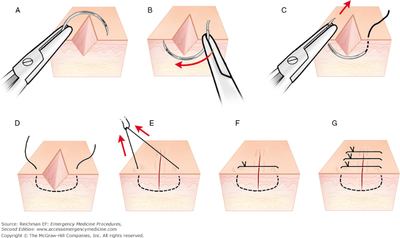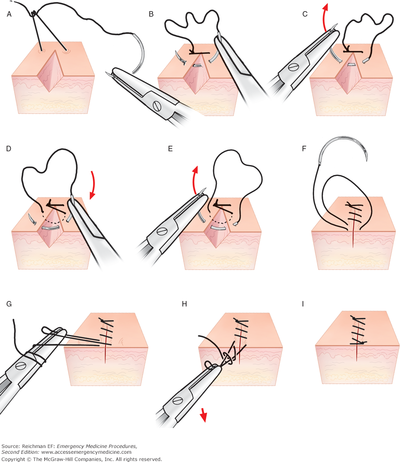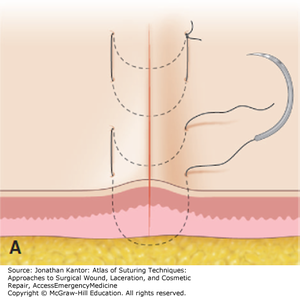Laceration Repair
Small lacerations may be closed with adhesives (Dermabond) or tape (Steri-strips). Larger lacerations are closed with skin staples or sutures. There is no cosmetic difference between these two closure techniques, though skin staples are generally not used to close facial lacerations. Typically absorbable sutures (Vicryl, Monocryl, PDS, Chromic) are used subcutaneously and for closure of deep tissue layers and non-absorbable sutures (Ethilon, Prolene, silk) are used for skin closure. While absorbable sutures may be used for epidermal skin closure, especially if patient is unreliable and unlikely to return for suture removal, non-absorbable sutures should never be buried. Although there is common belief that use of absorbable sutures improve aesthetic appearance at the expense of increased risk of wound infection, studies have shown there is no difference in healing rates, subjective appearance of wound or rates of wound infection between suture types.
Suture size is based on wound location and matched to epidermal thickness. Size increases with # of 0s, and although there is a large range of sizes almost all closures in ER occur with 3-0 to 6-0 sutures. Typically 4-0 suture is appropriate for most skin closures regardless of location. 3-0 may be used on legs and back where there is tough skin. 5-0 is appropriate for facial wounds and 6-0 / 7-0 reserved for eyelid closures.
Sutures available in YKHC ER
- Ethilon – non-absorbable braided nylon. High tensile strength. Easy to use due to low memory. Higher risk of wound infection, not recommended for contaminated wounds. Also not preferred on scalp due to black color.
- Prolene – non-absorbable monofilament. Low tensile strength. Lower risk of wound infection, recommended for contaminated wounds when closure is deemed necessary. High memory, somewhat reduced by gently stretching line prior to suturing. Blue color makes for easy visualization for removal.
- Vicryl – absorbable braided. Easy to use due to low memory. Used for subcutaneous closures, closure of muscle layers and closure of dead-space.
- Chromic – absorbable monofilament. Natural collagenase typically from bovine collagen. Rarely utilized due to high inflammatory effect and low tensile strength.
Deep closures
- Subcuticular sutures: While commonly used for post-operative wounds, running subcutaneous closures are rarely used for wounds made outside sterile environments. Subcutaneous closures are commonly used to close sterile wounds, e.g. following lipoma or non-infected cyst removal.
- Buried (deep) sutures: Buried simple interrupted or buried running sutures may be used in the ER for multi-layer closures when there is the need for closure of fascia or galea, closure of dermis, closure of deep muscle layers or closure of dead-space created by large amounts of subcutaneous fat. Figure-of-eight sutures are commonly used to control hemorrhage due to bleeding vessels.
Epidermal closures
- Simple interrupted sutures: Simple interrupted sutures are the most common type of suture used in the ER and are ideal for most basic wounds. There is no good data on how close to place sutures from each other or from the margin of the laceration, generally sutures are placed 0.2-1.0 cms from each other and an equidistance from the margin of the laceration.
- Running (continuous) sutures: Running sutures may be used in place of simple interrupted sutures and are optimal for rapid closure of large lacerations, especially where skin staples are not appropriate (e.g. facial lacerations).
- Horizontal mattress sutures: Horizontal mattress sutures are used to create wound eversion, thus improve wound appearance. They may be used in place of simple interrupted sutures anytime a simple interrupted suture would be used.
- Vertical mattress sutures: Vertical mattress sutures are retention sutures used to relieve tension from large lacerations. They may be used in conjunction with horizontal mattress or simple interrupted sutures.
Control of hemostasis
Failure to control bleeding leads to hematoma formation, thus while small venous bleeding is tolerated bleeding from arterioles or prominent venous bleeding needs to be controlled prior to wound closure. The vast majority of wounds will achieve hemostasis with pressure alone. The patient may apply pressure themselves or a pressure dressing may be placed to free the nurse and provider. If pressure fails to stop bleeding small bleeding may be controlled with chemical cautery (silver nitrate), electrocautery (Bovie), or figure of eight sutures. Absorbable hemostat (Surgicel) is available from the OR for placement into wound beds. Facial wounds and scalp wounds are highly vascular and should not be explored without materials readily available to achieve hemostasis.
Suture removal timing
Typically sutures of the face and neck are removed in ~ 5 days and sutures of the scalp and extremities are removed in 7-10 days. It is sometimes optimal to replace removed sutures with Steri-strips for reinforcement during healing.
Resources/References
- Thornsen et al. Basic Laceration Repair. N Engl J Med 2006; 355:e18. DOI: 10.1056/NEJMvcm064238
- Ethicon. Wound Closure Manual
- Forsch et al. Essentials of Skin Laceration Repair. Am Fam Physician. 2008 Oct 15;78(8):945-951.



